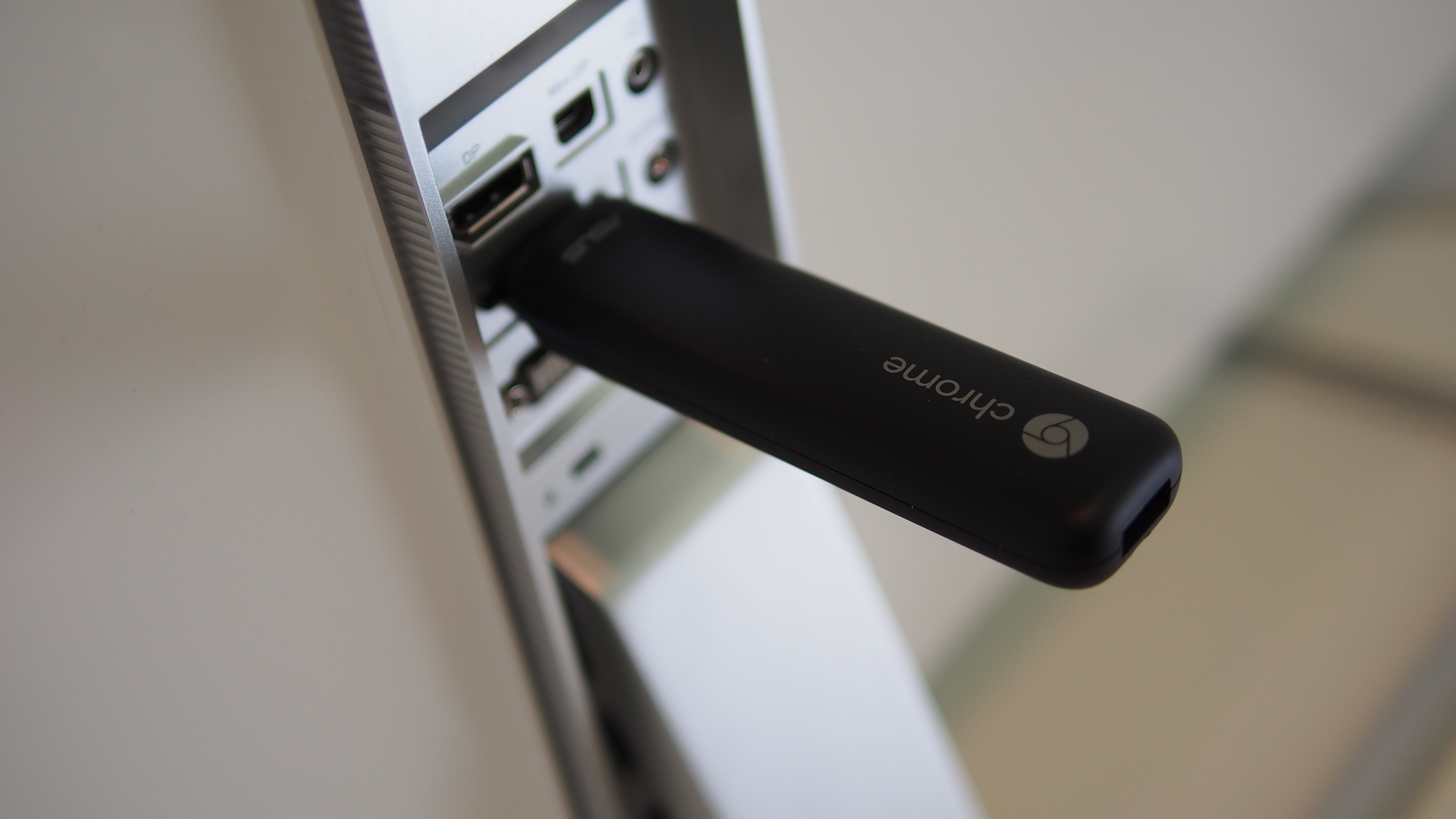TechRadar Verdict
The Chromebit is a compact, versatile HDMI dongle that transforms your existing display or TV into a Chrome OS-powered all-in-one. Chrome OS's lighter footprint makes better use of the limited hardware resources on the Chromebit, making it a better user experience than competing Windows-based PC-on-a-stick solutions.
Pros
- +
Portable form factor
- +
Easy setup
- +
Upcycle existing displays
Cons
- -
Single USB port
- -
Can't run desktop apps
- -
Limited storage
Why you can trust TechRadar
If you want to breathe new life into your existing monitor, projector or television, Asus's Chromebit is a simple $85 (£55, AU$118) solution that turns any display into a Chrome all-in-one PC.
The device is a simple way to upcycle your existing hardware, which you may find obsolete for your computing needs. If you've already upgraded your desktop to a 4K display, why throw away that perfectly good, but outdated, 720p desktop monitor? Just plug the Chromebit into the HDMI port, and the device converts your dumb display into a smart computing terminal. All you need to do is bring your own keyboard, mouse and Wi-Fi connectivity.

The Chromebit competes with similar PC-on-a-stick solutions, but many of the Chromebit's competitors run Windows. The Chromebit differentiates from the Intel Compute Stick ($149, £97, AU$206) and Lenovo's Ideacentre 300 ($99, £64, AU$137) by swapping Windows 10 for Chrome OS.
Going with Chrome OS may have been a smart choice for Asus. Even though Chrome is more limited in capabilities than Windows, it provides enough utility for most users looking to upcycle old hardware by allowing them to check their emails, browse the web, stream online videos and work on documents using Google's browser-based apps. More importantly, Chrome OS makes better use of the limited hardware resources on the PC-on-a-stick form factor. This leads to a faster, more fluid user computing experience than competing solutions that use Windows as the operating system.
Design
Unlike traditional desktop PCs that take up valuable workspace on your table, the Chromebit is an unassuming, matte black HDMI dongle that plugs into the rear of your monitor or HDTV.
Even though the device is small and travel-friendly, it's not exactly compact. At 4.84 x 1.22 x 0.67 inches (123 x 31 x 17mm), the Chromebit dwarfs my already large Kingston DataTraveler Ultimate USB 3.0 G3 flash drive, which measures 2.75 x 0.88 x 0.38 inches (70 x 22.4 x 9.7mm).
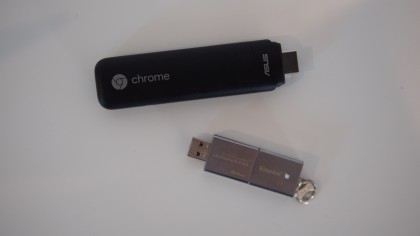
The Chromebit, with its elongated shape and rounded edges, is still more compact and lighter than carrying a Chromebook with you on a business trip, provided you don't need to use it while in transit, as it lacks a display, keyboard and trackpad or mouse. The device only weighs 0.17 pounds (85g).
Sign up to the TechRadar Pro newsletter to get all the top news, opinion, features and guidance your business needs to succeed!
The size and weight is roughly comparable to the Intel Compute Stick. The Chromebit is 0.78 inches (19.8mm) longer, 0.24 inches (6.1mm) more narrow and 0.2 inches (5.1mm) thicker than Intel's Windows-powered counterpart. The compactness of Intel's solution makes it even more impressive given that it is capable of delivering the full power of Windows in a similar footprint.

In addition to breathing new life into existing or old displays that you have on hand, business users can travel with the Chromebit, a Bluetooth keyboard and a wireless mouse and have a PC workstation wherever they can find a display. Because data is stored on your Google cloud and synchronized with your own hardware, the Chromebit delivers a more secure computing solution than a PC in a hotel business center or using a client PC in a remote office.
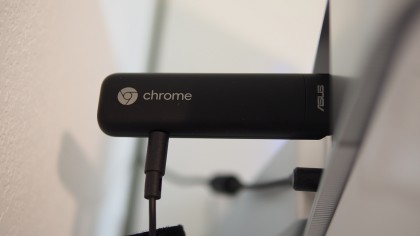
In my case, I have a 4K monitor at home, and plugging in the Chromebit instantly transformed my display into a Chrome OS-powered all-in-one.
Setup
The setup process was easy, requiring only a few steps. I plugged the Chrombit into the rear of my 4K monitor and connected the included power cable to the Chromebit. The dongle doesn't come with buttons, so once the power cable is attached, it instantly powers on. The only other port, besides the power port, on the Chromebit is a USB 2.0 port, which is located on the opposite end of the HDMI connector.
If you position your monitor or HDTV close to the wall, you'll need at least 10 inches of clearance from the rear of the display to accommodate the Chromebit and any USB cable. If you're adding a USB flash drive, you'll likely need more space between your display and the wall to accommodate the combined length of both devices. To mitigate space constraints in cramped offices, Asus included a 1-foot (30.5cm) HDMI extension cable.
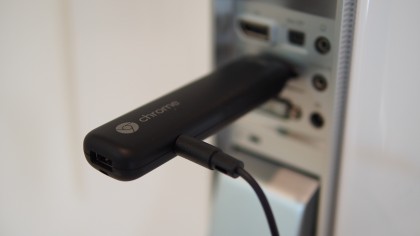
Once the unit powers on, a setup wizards walks you through connecting a keyboard and mouse, which you'll need to supply on your own. You can either use the USB port to connect wired peripherals, or the Bluetooth 4.0 connection to add wireless devices. Going the wired route may necessitate a mini USB hub for adding more than one USB accessory.
I opted to go the wireless route, and pairing a Logitech K810 Illuminated Bluetooth Keyboard ($99) and Logitech V470 Bluetooth Laser Mouse (discontinued; pricing unavailable) was easy. Once the keyboard and mouse were turned on and in pairing mode, the Chromebit recognized both devices immediately. Connecting the keyboard required a passcode, which was generated and displayed on my monitor, and the mouse paired without any issue.
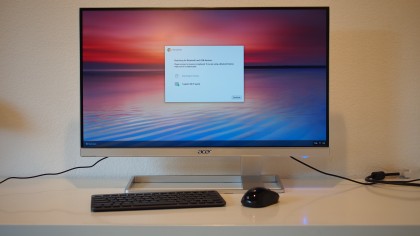
After the devices connected, the Chromebit asks you to find your wireless network and enter your network password to connect to the internet. Once the device connects to your network, the setup process continues by downloading any updates available on Google's servers. At the end of the process, you'll be able to enter your Google account credentials to log in.
